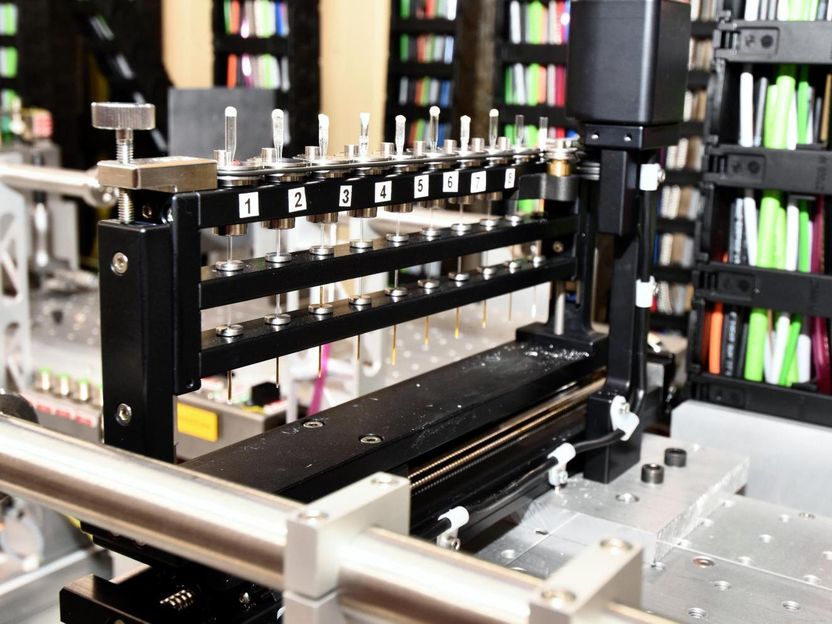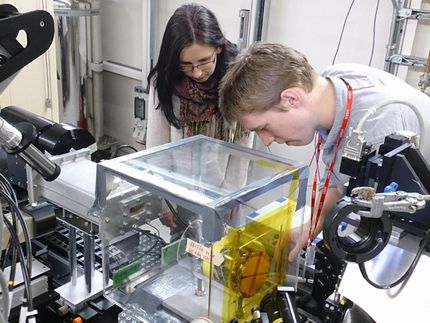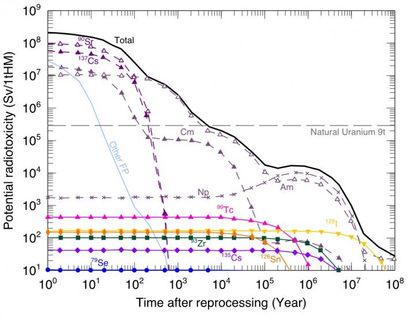Exploiting high speed light for super slow science
Scientists at the world's premier science conference - the American Association for the Advancement of Science (AAAS) annual meeting - will this year be discussing the advances enabled by the UK's pioneering Long-Duration Experiment facility (LDE). Unmatched anywhere in the world, the LDE allows scientists to closely study the atomic and molecular behaviour of matter under different conditions and over a period of two years.

Dr Claire Corkhill, Sheffield, investigating the hydration of cements used by the nuclear industry for the storage of waste.
Photograph By: Sean Dillow. www.TheBigCheesePhotography.co.uk Diamond Light Source.
Based at the UK's synchrotron science facility, Diamond Light Source, the LDE exploits powerful synchrotron light -- which is 10 billion times brighter than the sun -- to penetrate to the heart of matter. But unlike Diamond's 25 other experimental stations, the LDE allows scientists to study the behaviour of material as it changes over an extended period of time, meaning that experiments can last not hours or days, but months or years.
Prof Trevor Rayment, Diamond's Director of Physical Sciences, "Historically, synchrotrons have been racing to provide scientists with experimental tools that glean rapid results. On some of our beamlines, we can now study hundreds or even thousands of samples each day. In areas like structural biology this is vitally important and super fast experiments have become quite routine at Diamond. However, we know that many scientific problems actually call for research to happen on super slow timescales and, counterintuitively, this research is actually much harder to plan for and to succeed in. Diamond's new LDE facility is already helping researchers to conduct long term experiments, focusing on areas such as making better batteries, improving the effectiveness of drugs in hot climates, and testing cement that can be used in the disposal of radioactive materials in the UK's planned geological disposal facility (GDF)."
The LDE is a unique facility and a resource designed to address problems that simply cannot be solved anywhere else. Diamond's synchrotron light illuminates samples around 1000 times better than laboratory microscopes. As well as providing an in-depth insight into materials over an extended period, the LDE can also be tailored to specific temperature or levels of humidity, meaning that scientists can assess material's long-term behaviours in varied environments.
The long-term behaviour of materials has never been studied in this level of detail before, and the facility is revealing new insights into how materials interact on the atomic scale under different conditions and over time.
One of the key projects currently taking place at this world-leading facility is looking into the long-term behaviour of nuclear waste cement as it gradually becomes hydrated by water. This work, led by Dr Claire Corkhill from the University of Sheffield's NucleUS research group, could be vital to informing the UK's strategy on radioactive waste disposal.
Claire explains: "The UK government plans to bury the most dangerous form of its radioactive waste in a geological disposal facility deep underground - somewhere between 200 and 1000 metres under the surface. To put this in context, the London Underground at its deepest is only 65 metres down.
"But because it can take hundreds of thousands of years for this waste to decay to a safe level, the facility needs to be able to endure for an extremely long time. That's why this study is so vital to energy research. By studying the molecular reactions between cement and water over two years, our team can extrapolate the impact over a much longer period."
Claire will be presenting her pioneering work on radioactive waste disposal at the AAAS conference this February 14th. As part of a symposium entitled Cleaner Energy Solutions: What Can 21st Century Large-Scale Physics Deliver? Claire will make up a panel of three leading energy scientists.
Together, the group will discuss their individual research projects and equip the audience with an understanding of pragmatic, achievable solutions to the global warming challenge. This is the ultimate goal for research like Claire's and, with the support of cutting-edge facilities like the LDE, scientists are helping to develop our approach to the challenges presented by climate change. Energy research is just one of the many areas in which the LDE can provide scientists support. The facility puts a call out once each year, and an external panel of experts selects the most intriguing scientific research for further study. Professor Chiu Tang is Principal Beamline Scientist for I11 and the LDE facility. He says: "We are here to support a class of experiments that could not otherwise be done within the existing science infrastructure. And that's what we're looking for - problems that couldn't be solved any other way and the opportunity to open up avenues of enquiry that have never been thought possible before."





























































